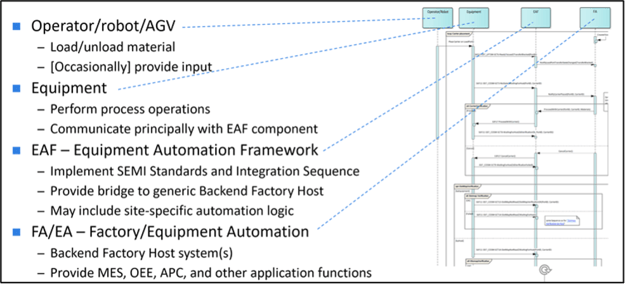SEMICON West 2021 wrapped up last month and despite being a hybrid event with limited attendance, there was nevertheless a lot of excellent technical information available through the various SEMI-organized programs. One such program was the Smart Manufacturing Pavilion which featured a series of “Meet the Experts” presentations on Tuesday afternoon, December 7.
Our own Alan Weber (VP of New Product Innovations) was privileged to be included, and his talk was titled “Accelerating Advanced Backend Automation through Smart Application of Frontend GEM 300 Standards.” The presentation was co-authored by Michael Kollex, Swee Shian Yap, and Olaf Herzog of Infineon Technologies, who also developed and contributed much of the technology that was discussed. But we’re getting ahead of ourselves…
Background
Automating assembly, packaging and test facilities has always faced challenges not seen by their upstream wafer fab counterparts. These include (but are not limited to):
- Multiple material transformations (and associated carrier types)
- Linear flow shop manufacturing operations (vs. cyclical)
- High product variety and velocity
- Significant manual intervention
- Complex unit product traceability requirements
- Low (relative to wafer fab) equipment cost and automation budget
- Equipment supplier un-familiarity with SEMI Standards
- Handling multiple data source types/protocols
In mid-2019, a new SEMI Standards task force—the Advanced Backend Factory Integration Task Force (ABFI TF)—was created to address these challenges.
An important operating principle of this task force is to ensure that any new standards identified for the assembly and packaging segments are not only technically consistent with the existing body of connectivity and control standards but also directly leverage as much of the current SEMI automation standards as possible. This is especially important for the capabilities covered by the GEM 300 (Generic Equipment Model) standards since GEM is already well adopted by many of the equipment suppliers to the backend assembly, packaging, and test market.
However, this still leaves a gap that must be filled by the automation requirements for each factory customer, which is precisely what the work described in this presentation accomplishes in a way that serves the entire industry.
Solution Approach
The approach to this problem features several key innovations.
The first key innovation is the definition of a detailed “Target Equipment Integration Sequence” applicable to all equipment types that supports full automation of assembly and packaging operations while eliminating the ambiguity that raises implementation costs for equipment suppliers and factory engineers alike. The scope of this sequence for a given unit of equipment covers its entire operation, from loading material carriers and verifying their content; mounting, usage tracking, and unmounting of consumables and durables that are directly associated with the products being manufactured (a key traceability requirement); creating the process/control jobs appropriate for that material and retrieving the associated process recipes; tracking execution of those jobs and accumulating the data items required for single device traceability; storing that data in the substrate map data structures; and passing that information back to the factory systems.
The specific expression of this integration sequence is a ladder diagram of the system communication partners, which include an operator/robot, the equipment, an Equipment Automation Framework (data collection server), and the Factory Information and Control System(s). This is shown in the figure below.
 The second key innovation is basing the messages that constitute this sequence on existing, mature SEMI GEM 300 standards, thereby reducing (and eventually eliminating) the need for custom implementation software. Amazingly, except for the need to support “nested carriers,” realizing the integration sequence requires almost no modifications to the existing GEM 300 standards.
The second key innovation is basing the messages that constitute this sequence on existing, mature SEMI GEM 300 standards, thereby reducing (and eventually eliminating) the need for custom implementation software. Amazingly, except for the need to support “nested carriers,” realizing the integration sequence requires almost no modifications to the existing GEM 300 standards.
The third key innovation is realizing this integration sequence in a sample application suite to bring the specification to life and provide a reference implementation to accelerate the development process. This includes 1) an equipment simulator that faithfully implements all the capabilities called for in the integration sequence, 2) a sample factory host application that serves as the principal communications partner for the equipment during the implementation of the integration sequence by a specific equipment supplier, and finally 3) a set of automated tester “plug-in” modules for validating that the equipment-side implementation has in fact met the requirements. Together these software modules greatly reduce the time it takes to understand, implement, and test these important new specifications. This software suite is depicted in the figure below.
 The fourth innovation is more procedural than technical: by openly sharing this design with the industry standards community, we believe it will be enhanced and further generalized by other assembly and packaging thought leaders, increasing the level and sophistication of overall automation capability while lowering integration and operation costs across the industry.
The fourth innovation is more procedural than technical: by openly sharing this design with the industry standards community, we believe it will be enhanced and further generalized by other assembly and packaging thought leaders, increasing the level and sophistication of overall automation capability while lowering integration and operation costs across the industry.
What’s Next?
Next steps include promoting this design to potential stakeholders through webinars and regional training events, gathering and incorporating feedback into the key artifacts, and validating its applicability in multiple manufacturing sites.
Where Can I Get the Presentation?
A fully narrated version of the presentation is available here; we hope you find it useful, and please contact us with any questions. We wish you the very best on your company’s backend automation – let us know how we can help!





